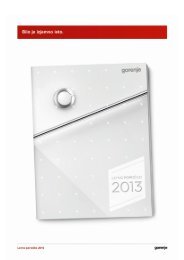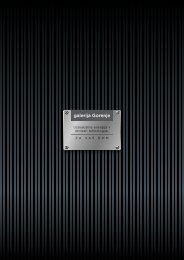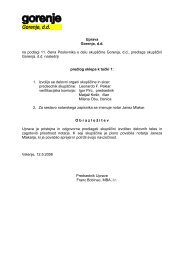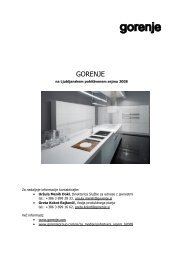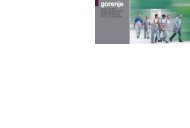Annual Report Gorenje Group 2009
Annual Report Gorenje Group 2009
Annual Report Gorenje Group 2009
Create successful ePaper yourself
Turn your PDF publications into a flip-book with our unique Google optimized e-Paper software.
Credit, currency and interest rate risks as well as risks of financial solvency are key kinds of financial<br />
risks for the <strong>Gorenje</strong> <strong>Group</strong>. Due to the increasingly difficult macro-economic situation in <strong>2009</strong> the<br />
special attention was paid to credit risks to which the <strong>Group</strong> was exposed in compliance with the<br />
assessment of the management board. They include all risks where economic benefits of the <strong>Group</strong><br />
are reduced due to unsettled contractual obligations of business partners. The following measures<br />
have been taken for their control:<br />
• security of the major part of operating receivables with the Slovene Export Company (SID) -<br />
Prva kreditna zavarovalnica d.d. and other insurance companies,<br />
• risks receivables due from customers have been additionally secured by bank guarantees and<br />
other security instruments,<br />
• the financial position of new and existing business partners has been regularly controlled and<br />
limits on maximum exposure have been set,<br />
• joint and chain offset with customers have been carried out,<br />
• credit limits and collection of receivables have been controlled.<br />
Due to geographic diversification of operation the <strong>Gorenje</strong> <strong>Group</strong> has been greatly exposed to<br />
currency risks where the economic benefits of the company may decrease due to changes in the<br />
exchange rate of an individual currency. The exposure of cash flows and balance sheet has been<br />
considered in the valuation of risks. These risks are high in the markets of Serbia, Great Britain, Czech<br />
Republic, Slovakia, Poland, Hungary, Croatia, Turkey, and in all US dollar markets. Special attention<br />
has been paid to the control of currency risk by regulation of sales and purchasing in a separate<br />
currency. Futures contracts and short-term borrowings in local currency have been used as protection<br />
against short-term currency fluctuations.<br />
In recent years great attention has been paid to interest rate risks that may reduce economic benefits<br />
of the company due to a change in interest rates in the market. In the financial year <strong>2009</strong> the share of<br />
loans with a fixed interest rate or those secured by derived financial instruments grew. At the end of<br />
<strong>2009</strong> their share accounted for 47.5 % of the credit portfolio of the <strong>Gorenje</strong> <strong>Group</strong>.<br />
Liquidity risk includes risks associated with the lack of financial resources available and consequently<br />
the inability of the company to settle its liabilities within the time limits agreed. The financial liabilities of<br />
the <strong>Gorenje</strong> <strong>Group</strong> amounting to 192.0 million EUR mature in the year 2010 and therefore discussions<br />
with banks relating to the re-financing of the existing financial liabilities started. The liquidity reserve as<br />
at 31 December <strong>2009</strong> amounting to 162.7 million EUR consisting of unutilised revolving lines, shortterm<br />
time deposits at banks and cash on accounts of the <strong>Gorenje</strong> <strong>Group</strong> have provided appropriate<br />
short-term regulation of cash flows and liquidity of the <strong>Group</strong>.<br />
The risk of short-term liquidity of the <strong>Gorenje</strong> <strong>Group</strong> has increased due to the reduction in availability of<br />
financing sources of our business partners who sell or purchase the goods. The risk of long-term<br />
liquidity is moderate and a consequence of successful operation, efficient asset management,<br />
sustained ability of generating cash flows from operating activities and suitable equity structure.<br />
OPERATING RISKS<br />
Operating risks include a reduction in economic benefits of the <strong>Group</strong> arising from the ability of<br />
unsuitable planning, performance and control of business processes and activities.<br />
When controlling production risks the emphasis has been placed on the operation of key<br />
equipment (machines, tools, production lines) and infrastructure involving undisturbed supply with<br />
energy products and appropriate management of hazardous substances. The production risk is greater<br />
in line production and it is controlled by qualifications of employees and regular maintenance of<br />
production lines.<br />
79<br />
<strong>Annual</strong> <strong>Report</strong> <strong>Gorenje</strong> <strong>Group</strong> <strong>2009</strong>



